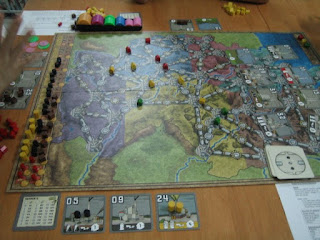The boardgame style that I like most is Eurogames. They are usually short (mostly 45 minutes to less than 1.5 hours). Their rules are usually concise and streamlined. There is usually meaningful decision making. Most games have some luck element (some more-so than others), but it is usually not a dominating factor. In most cases you do need to strategise and plan smartly to win. These are the strengths of Eurogames. One of their weaknesses is sometimes there is a disjoint between the gameplay and the theme. Sometimes the games feel like a mathematical or logical puzzle or exercise, and it seems any theme can be applied to it. The theme seems to be needed to enhance the playing experience and the imagination, rather than the game itself being designed with the theme or story in mind. This is one of the complaints some people have on Eurogames, and I think there is some truth in it.
I'm getting a little off topic here. Coming back to the length of Eurogames, most of them are relatively short and are suitable for playing casually, like as a family game. However there are some longer and more complex Eurogames too, e.g. Age of Steam and Power Grid. Most boardgame hobbyists tend to gravitate towards such games, because they are willing to invest more time and effort to learn and to play these games, and they gain more satisfaction out of these games. Among American style games, there is probably a higher percentage of longer games. There are some of these that I like too, like games in the Axis & Allies series, and Hammer of the Scots.

"Long and complex" is relative. My "long and complex" games are games that can last from 1.5 hours to 5 hours, and their complexity is about the complexity of Hammer of the Scots. To hardcore wargamers, this level of complexity and this type of game duration are peanuts.
So why do I like some of these longer and more complex games? Some of these longer games can really tell a story - how the German offensive surged and then dissipated in Axis & Allies: Battle of the Bulge, how civilisations rose and fell in History of the World. Sometimes you create your own story - how Japan conquered India, Moscow and Alaska during World War II (Axis & Allies), how William Wallace (Braveheart) was trapped and killed before he ever started his rebellion (Hammer of the Scots) (of course, that would probably make a short game). You can really immerse yourself in the story and the experience.
Longer games also allow longer term planning and strategising. You decide on a strategy and try to execute it. You watch the game unfold and see the impacts of your previous moves. Sometimes twists of fate force you to adjust your plans. Sometimes your opponents' moves force you to change tactics. The momentum picks up, the table turns, the tension builds as your mind races to consider the emerging opportunities and approaching dangers. Playing through a long exciting game can actually be a tiring experience, but it is also very fulfilling. You really get into the game and get very involved and very attached.
I have played a complete game of A Game of Thrones only once, with Han, Chee Seng and Ricky. This game is based on the A Song of Ice and Fire series of novels, the first book being A Game of Thrones. Players are great Houses (clans) in the fictitious land of Westeros, and vie to win by conquering a specific number of cities, or to control the most number of cities by the end of Round 10. Battles are very simplistic and deterministic, so diplomacy, collaboration and treachery (at the right time) becomes important. In this game, players plan actions secretly, then reveal their planned actions simultaneously, and only after that they execute the actions. So, there is also an element of bluffing, of double guessing your opponents.
In our game, I played House Baratheon (yellow, in the south east), Han played House Tyrell (green, in the south west), Chee Seng played House Lannister (red, in the middle) and Ricky played House Stark (white, in the north). Bloodshed started early between Han and I. After losing an infantry to him early in the game, I became obsessed with attacking him. His House had become my sworn enemy. Chee Seng fought mostly with Ricky. There were fewer battles between them, but some of these battles were larger in scale. After a few exchanges, Ricky backed off back to the north a little, in order to consolidate more power to prepare for a major strike. Chee Seng inconspicuously conquered the Greyjoy lands (islands, to be more accurate). Greyjoy (black) was supposed to be played by the fifth player, but since we only had four, this House was just a passive House. Then, to everyone's surprise, Chee Seng struck out and conquered 7 cities, and won an instant victory. We had not been watching his army positions closely and allowed him to win early.
That single game of A Game of Thrones was a very involved game. I enjoyed the tension of trying to out-guess your opponents, and also the tension of who will blink first and betray his ally. Treachery is only a matter of sooner or later, because afterall there can only be one winner.
This post is getting long. I'm splitting it up.

































